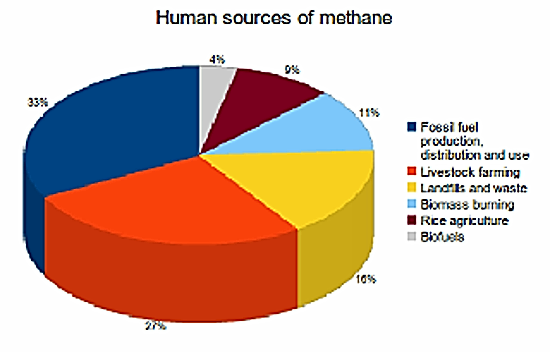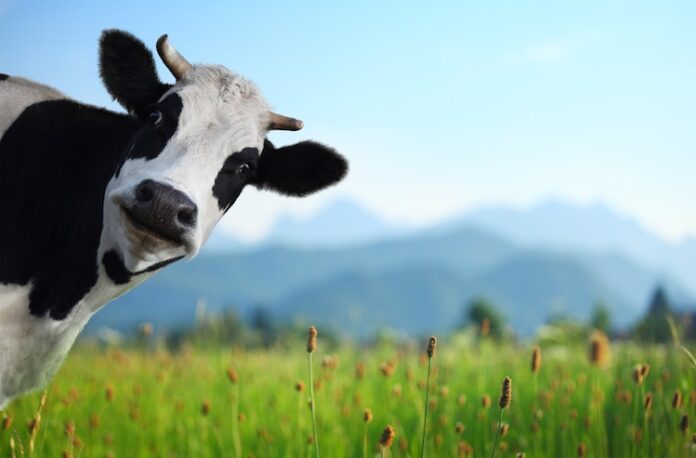Methane (CH4), a simple molecule with one carbon and four hydrogen atoms, is far less complex than carbon dioxide (CO2) and an 80 times greater contributor to short-term global warming (within 20 years).
On a century timescale, CH4 packs 28 times the punch of CO2 as a greenhouse gas (GHG). And since the beginning of the Industrial Revolution, its atmospheric accumulation has more than doubled. Currently, CH4 is responsible for approximately 20% of atmospheric warming.
The biggest human sources of CH4 by percentage can be seen in the following pie chart.

Tackling Fossil Fuel Methane Emissions
Fossil fuel production, distribution, and use account for the largest share. But livestock farming is a close second. In the case of the former, the known sources are lead by oil and natural gas, with coal and bioenergy contributing the least. Solutions for oil and gas are largely manageable through above-ground actions that include repairing existing equipment and deployment of proven technologies. We are talking about leak detection equipment replacement to identify CH4 emissions.
The International Energy Agency (IEA) estimates through this simple operational improvement that 70% of CH4 emissions from the oil and natural gas sector can be avoided. And with the current spike in prices for oil and gas because of the Russian invasion of Ukraine, the sector would be able to absorb the cost easily. What this means is operations need to check and replace leaky pumps, corroded compressor seals, non-working electric motors, inadequate vapour recovery units, and both upstream and downstream leak detection monitors. The goal would be to plug the holes and eliminate the practice of non-emergency flaring and venting which today contributes to a large proportion of the industry’s CH4 emissions.
Tackling Livestock Methane Emissions
Last week New Zealand, the home to 6.3 million dairy and 3.9 million beef cattle, and 26.8 million sheep announced plans to tax farmers on CH4 emissions. Livestock in New Zealand outnumbers people by a factor of six. Cows and sheep contribute almost half of all CH4 emissions produced by the country.
A recent Guardian article reported that cows are one of New Zealand’s biggest producers of GHGs. Emissions from all sources in the country between 1990 and 2018 rose 57% which was “the second greatest increase of all industrialized countries” over that time span. So for the country to tackle its GHGs to meet a 2050 net-zero emissions target, it is bringing in a tax.
The tax is priced separately for short and long-term farm greenhouse gas (GHG) contributions. There is no mention so far of how GHGs will be measured to calculate the tax. For farmers, there are many unknowns. What can they do to reduce GHGs from livestock operations?
Herd reduction is likely the primary action farmers will take. Other ways to inhibit CH4 emissions may come from breeding new varieties of cows and sheep that burp and fart less.
Then there are changes to feeds. Since enteric fermentation occurs in the stomachs of cows and sheep, CH4 exhalations and flatulence can be reduced by changes to the food mix.
Back in 2016, a Canadian farmer on Prince Edward Island introduced seaweed he collected from local beaches into the diet of his dairy cows. What started as a practice to save money reduced CH4 flatulence by 20%. It’s not that the cows didn’t continue to burp and fart. The difference was there was no detectable CH4 coming out of either end.
Today, livestock farms around the world contribute more than 90 million tons of CH4 to the atmosphere annually. And because meat and dairy demand has doubled globally over the last half-century, so have herd populations and emissions. So the problem isn’t going to go away without significant changes to livestock management practices.
That’s why what New Zealand is attempting to do through a tax is something many other countries are watching and considering as they attempt to address agricultural emissions without dramatically upsetting the food supply.
New Zealand farmers will be given the opportunity to use carbon offsets by investing in on-farm forests. This will help offset the tax. But changing livestock management practices will be critical including the feed mix. And considering New Zealand is an island nation surrounded by the Pacific Ocean, finding seaweed as a feed shouldn’t be too difficult.
Eventually, however, the costs incurred by farmers will impact prices for meat and dairy. The government may consider some form of compensation to families to help offset rising prices because there is no doubt the entire country isn’t planning to suddenly go vegan.









